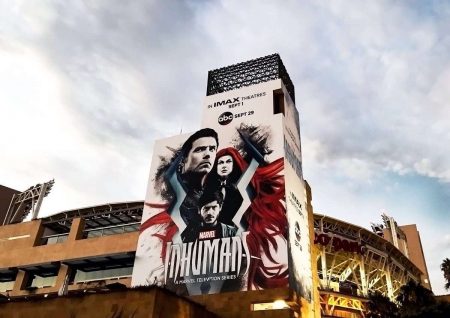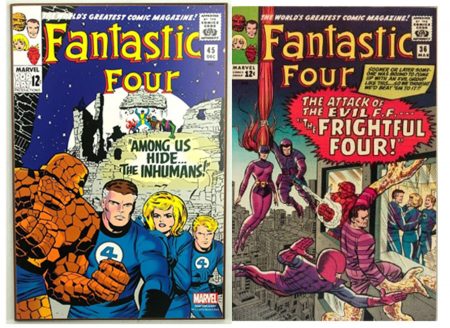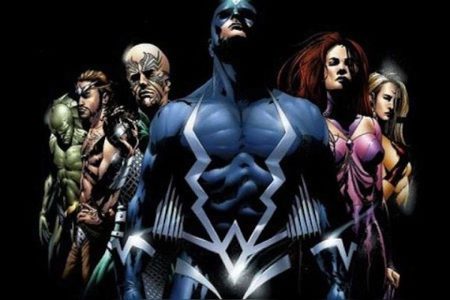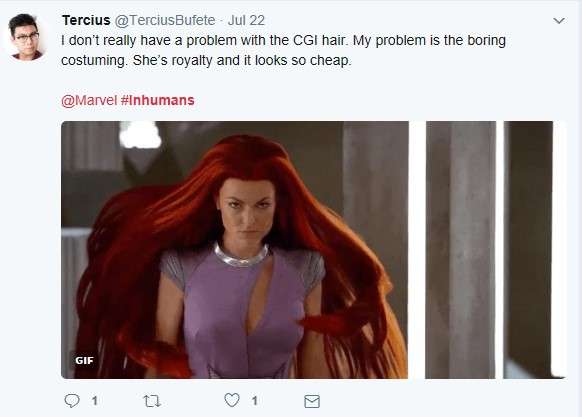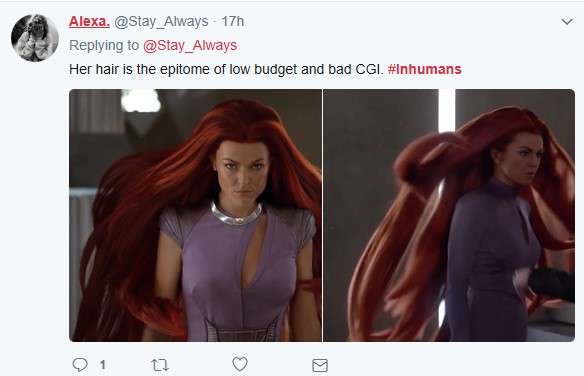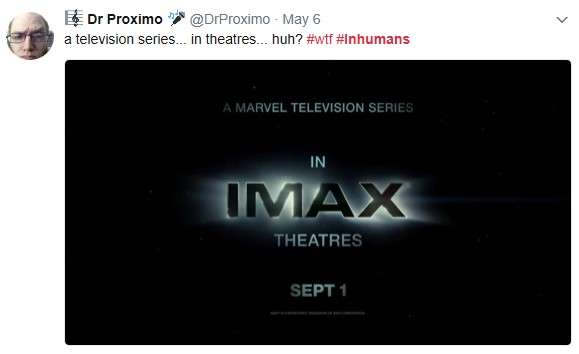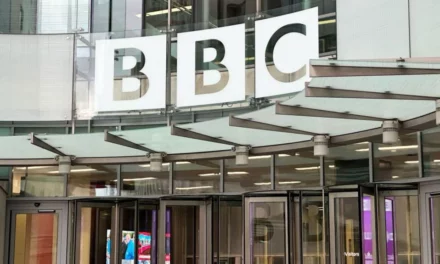The past weekend saw the annual San Diego Comic Con (SDCC) take place, an event which, as Lincoln Geraghty (2014: 96-103) has argued, has come to assume an increasing point of centrality within the screen industries as various intellectual property holders and brands use this to create buzz for new and returning series alike.
Regarding (cult) television drama, this year saw promotional strategies either extended or initiated for series including Twin Peaks (1990-1; 2017- ), Star Trek: Discovery (2017- ), The CW’s Arrowverse and Marvel’s upcoming televisual output including The Defenders (2017) for Netflix and new ABC series Inhumans (2017- ). This blog focuses on fan/audience reception of the latter because of both the less-than-positive discussions that Inhumans has generated and, arguably linked to how publicity material has been read, its complicated development period. Online reactions to what Jonathan Gray (2010: 120) calls promotional pre-texts for Inhumans has frequently been hostile with negative reactions to the trailer screened at SDCC last weekend following on from similar evaluations of the series’ first publicity shot released in May. By focusing on comments posted to Twitter, an understanding of how a contemporary fan-audience negotiates various discourses linked to what I will refer to here as ‘quality-mainstream-cult’ television can be debated.

Figure 2: Official press photo for Inhumans released in May revealing (from left to right) Gorgon (Eme Ikwuakor), Karnak (Ken Leung), Black Bolt (Anson Mount), Medusa (Serinda Swan), Crystal (Isabelle Cornish) and Maximus (Iwan Rheon).
For readers who are unfamiliar with who or what the Inhumans are here is a quick primer: they were first introduced into Marvel’s comics during the 1960s where the characters of Medusa (the Inhumans’s queen who’s long hair doubles as a binding weapon) and Gorgon (who can start seismic attacks through the power of their legs) were initially adversaries of the Fantastic Four. Since then, the Inhumans’s back story has expanded to position them as a hyper-evolved offspring of humanity who are native to the fictional city of Attilan (a mobile location located at different times on the Moon, in the lost city of Atlantis and in the Himalayas).
The Inhumans roster has also expanded to include Black Bolt (husband to Medusa and the Inhumans’s King who is mute due to the destructive capabilities of their voice), Crystal (Medusa’s sister who can control the elements), Karnak (a specially engineered Inhuman with superhuman strength), Maximus (Black Bolt’s treacherous brother) and Lockjaw (an abnormally sized, formerly human, teleporting dog. No, really.). Frequently understood as ‘Marvel’s royal family’, the term ‘inhumans’ currently gains its greatest recognition within Marvel’s screen media through ABC’s Agents of S.H.I.E.L.D. (2013- ) where ‘inhuman’ characters have featured (most notably Chloe Bennet’s Quake).
Immediate reactions to the summary provided might provoke a raised eyebrow from some scholars: Inhumans potentially exemplifies pulp SF at its best/worst, lacking in the social commentary that has been valued in (British) TV drama and has subtextually-defined other celebrated Marvel screen properties. Jessica Jones’s (2015- ) engagement with feminist issues about PTSD and abuse provides the most obvious reference point here. Additionally, some scholars may question whether television really needs another Marvel-derived series. The brand’s current output after all includes the aforementioned Netflix and ABC shows (along with others such as Luke Cage (2016- ) and Daredevil (2015- )) as well as the forthcoming teen-orientated Cloak and Dagger (2018- ) and The Runaways (2018- ) for Freeform and Hulu respectively. Might we not have reached saturation point for superhero television?
Subscribing to this position means settling for the value-laden understanding of media franchising that Derek Johnson (2013: 2) defines as “an industrially driven process perceived as unchecked expansion and assimilation across cultural contexts”. Adopting this perspective nevertheless overlooks both the forms of industrially-located creativity and agency that franchise workers engage in (which Johnson excellently outlines) and rests upon passive understandings of audiences as blind consumers who uncritically devour each franchise iteration. As I’ll now outline, reactions to initial promotional material for Inhumans have largely been hostile, telling us much about viewers’ expectations for ‘quality-mainstream-cult’ TV drama.
Much of the hostility that online commentators have directed towards Inhumans’s pre-texts concerns the show’s implied aesthetics. As the tweets below show, elements including the show’s production values in terms of costuming and special effects, frequently centred on the realisation of Medusa, have provided the locus for expressions of negativity:
Such expressions can, following S. Elizabeth Bird’s (2003) study of audience evaluations as ‘popular aesthetics’, be read as indicative of the taste preferences of a particular (sub)section of the television audience. On the one hand, positioning Medusa’s realization (rather than any of the male characters) as the stand out ‘fail’ of these pre-texts underlines how evaluations of ‘quality’ in TV drama are culturally gendered (see Lotz 2014). On the other, these comments and others indicate how a discourse of commercialism, structured around policing the boundaries between ‘professional’ and ‘amateur’ creativity, has underpinned audience interpretation. The implications of this being that, despite living in an era of increased interaction between ‘audiences’ and ‘media producer’ identities, expectations about professional aesthetics rooted in what Charlotte Brunsdon (1997: 142) names “upper-middle class taste codes” of getting the money onscreen in an appropriate manner continue to structure audience anticipations for brand-derived TV series on major US networks. The underlying assumption guiding these expressions of hostility being that the money either hasn’t been there or it hasn’t been well spent:
The negativity expressed through these comments is partly significant because of Inhumans’s housing under a transmedia brand such as Marvel which produces blockbuster cinema featuring expensive effects set-pieces and A-list stars as well as ‘edgy’ and ‘realist’ television series (e.g. its Netflix commissions). Inhumans has previously been aligned with these brand expectations as, when first announced in 2014, it was intended as an instalment within the Marvel Cinematic Universe (MCU). However, unforeseen developments led to the project first being pushed back from its initial intended release date of 2018 and then altogether removed from the MCU’s schedules. The sudden and unexpected announcement that Inhumans would be moving forward as a television series for the mainstream US broadcaster ABC, but that its first two episodes would be released to cinemas as a one-off IMAX event, consequently suggested institutional ambivalence about where the project would ultimately sit.
Cinema releases for ‘event’ episodes of television series are, of course, an emerging trend. Season debuts or finales, anniversary episodes, and one-off specials of ‘quality’ shows like Game of Thrones (2011- ), Sherlock (2010- ) and Doctor Who (1963-89; 1996; 2005- ) have all utilised these strategies to signify the ‘value’ (whether cultural, technological, economic, or all three) of these series (Hills 2015: 93-104). However, audience reactions to pre-texts for Inhumans extend the institutional ambivalence towards the property by suggesting the enhanced scope, scale, and budget expected of ‘quality’ cinematic’ TV has not been realised in this case:
What’s especially interesting about these audience evaluations is how they navigate discourses of not only ‘quality’ television but also those concerning ‘cult’ and ‘the mainstream’. Much like debates about ‘quality’ television, labels of ‘mainstream’ and ‘cult’ status have been theorised as discursive and open to different definitions between cultural sites of production, publicity and reception. Whilst discourses of ‘the mainstream’ have received less attention in TV Studies than in relation to other media forms such as popular music (Huber 2013), previous arguments offered by Matt Hills (2004) and Catherine Johnson (2010) have highlighted that who designates ‘cult’ status and where this becomes assigned constitutes struggles over the term’s cultural meanings. In short, ‘cult’ cannot be reduced to an industrially assigned discourse. Instead, the term arises through the ongoing negotiation between institutionally determined labels, a set of textually identifiable ‘family resemblances’ (Hills 2002: 131), and the agency and readings of these by a dedicated fan audience.
Amongst understandings of ‘cult’ television within fan communities a campy aesthetic has, however, contributed towards a show gaining ‘cult’ appeal. As Umberto Eco (2008 [1986]: 68) infamously stated the ability to “break, dislocate, [and] unhinge” a popular culture text and “remember only parts of it” (Ibid.) encourages cult audience attachments. Given that online respondents are snarkily reading Inhumans in terms of “its glorious ricketiness” (Ibid.), then, what do audiences’ singular valuations of discourses linked to ‘quality’/’cinematic’ television in this instance tell us about how these respondents perform the ‘value’ of US network TV drama?
Rather than singularly being developed as ‘cult’ TV, Inhumans has instead been made in line with dominant ideas constituting ‘mainstream-cult’: serialised drama which draws from a pre-sold ‘cult’ property but, by necessity, is institutionally required to widen its appeal to multiple niches through developing multiple production-located strategies (Johnson 2005: 133-4). These include downplaying or off-setting the property’s ‘cult’ associations by adhering to popular memories of the property, minimising ‘fannish’ aspects of canon, and, in the case of network drama in the US, employing narrative strategies that do not alienate an occasional viewership (Hills 2010: 218-225).
However, I would argue that discourses of ‘mainstream-cult’ TV drama should be extended to instead debate the concept of what I have called ‘quality-mainstream-cult’ programming. This term involves combining discussions of ‘mainstream cult’ drama with Johnson’s (2005: 99-102) arguments concerning ‘quality/cult’ TV via The X-Files. As Johnson (Ibid. 101) identifies, The X-Files developed a “layered address to different taste markets” through its ‘tasteful’ approach to representing fantastic imagery (amongst other things) which permitted ‘quality’ and ‘cult’ audience profiles to be targeted whilst also sustaining ‘mainstream’ appeal. Such demands also institutionally structure Inhumans: it strives for ‘quality’ judgements through a cinema-based release and, hopefully, demonstrating taste-appropriate aesthetics whilst also satisfying Marvel fans (old and new) at the same time as sustaining wider mainstream appeal.
However, in terms of the audience reactions to pre-texts for Inhumans discussed here, it is arguable that the discourses structuring evaluations of ‘quality-mainstream-cult’ TV on major US networks are negotiated in a way akin to managing the different levels on a sound mixing desk. This is because certain discourses are either lowered or heightened at different points throughout the reception process. What’s curious, however, is that readings of pre-texts have maximised the ‘quality’ discourse over embracing the show’s potential niche-cult appeal.
The prevalence of the ‘quality’ discourse is, on the one hand, unsurprising given Inhumans’s culturally-gendered source material and the dissonance between discourses of the feminised ‘mainstream’ and masculine ‘quality’ TV. Nevertheless, complete exclusion of the discourse of ‘mainstream’ appeal arguably hasn’t occurred as concerns about how wider audiences will read the show’s aesthetic strategies are alluded to in the above comments via demonstrating a concern for how other non-fan audiences may read the pre-texts. This aspect of audience responses recalls how John Tulloch and Henry Jenkins (1995: 145) discussed fan groups as a ‘powerless elite’ who show knowledge of “the ‘wider public’ whose continued following of the show can never be assured”.
On the other, in rejecting reading positions linked to ‘cult’ discourses, online commentators perform their identities as tastemakers by distancing themselves from textual elements that can be read in relation to industrial appropriations of ‘cult’ tastes. Rather than making aesthetic judgements based around a subculturally-agreed-upon ‘essence’ of what the Inhumans should look like, they are instead reading pre-texts through dominant, upper-middle class definitions of ‘quality’ television.
In short, fans’ negative reactions to pre-texts for Inhumans demonstrate an awareness of the imagined audience profiles that feed into the production of what I have called here as ‘quality-mainstream-cult’ television but have distanced themselves from ‘cult’ readings as a result of factors including the institutional ambivalence demonstrated towards the property. These negotiations involve interpreting, incorporating and distancing their performed online identities away from certain cultural discourses whilst nevertheless heightening others.
It’ll be interesting to see whether and how this discursive mix shifts once the IMAX screenings have taken place.
Ross Garner is a lecturer in Television Studies in the School of Journalism, Media and Cultural Studies at Cardiff University. He has published many book chapters and journal articles linked to debates concerning cult TV, institutionality and promotional aspects of TV culture. He is currently preparing the monograph Nostalgia, Digital Television and Transmediality for Bloomsbury.
Bibliography
Bird, S. E. (2003) The Audience in Everyday Life: Living in a Media World. London: Routledge.
Brunsdon, C. (1997) Screen Tastes: Soap Opera to Satellite Dishes. London: Routledge.
Eco, U. (2008 [1986]) ‘Casablanca: Cult Movies and Intertextual Collage’, in E Mathijs and X Mendik (eds.) The Cult Film Reader. Maidenhead: Open University Press. pp. 67-75.
Geraghty, L. (2014) Cult Collectors: Nostalgia, Fandom and Collecting Popular Culture. London: Routledge.
Gray, J. (2010) Show Sold Separately: Promos, Spoilers, and Other Media Paratexts. New York: New York University Press.
Hills, M. (2002) Fan Cultures. London: Routledge.
Hills, M. (2004)
Hills, M. (2010) Triumph of a Time Lord: Regenerating Doctor Who in the Twenty-First Century. London: I.B. Tauris.
Hills, M. (2015) Doctor Who: The Unfolding Event – Marketing, Merchandising and Mediatizing a Brand Anniversary. Basingstoke: Palgrave-MacMillan.
Huber, A. (2013) ‘The Mainstream as Metaphor: Imagining Dominant Culture’, in S Baker, A Bennett and J Taylor (eds.) Redefining Mainstream Popular Music. London: Routledge. pp. 3-13.
Johnson, C. (2005) Telefantasy. London: BFI.
Johnson, C. (2010) ‘Cult TV and the Television Industry’, in S Abbott (ed.) The Cult TV Book. London: I.B. Tauris. pp. 135-147.
Johnson, D. (2013) Media Franchising: Creative License and Collaboration in the Culture Industries. New York: New York University Press.
Lotz, A. (2014) Cable Guys: Television and Masculinities in the Twenty-First Century. New York: New York University Press.
Tulloch, J. and Jenkins, H. (1995) Science Fiction Audiences: Watching Doctor Who and Star Trek. London: Routledge.


